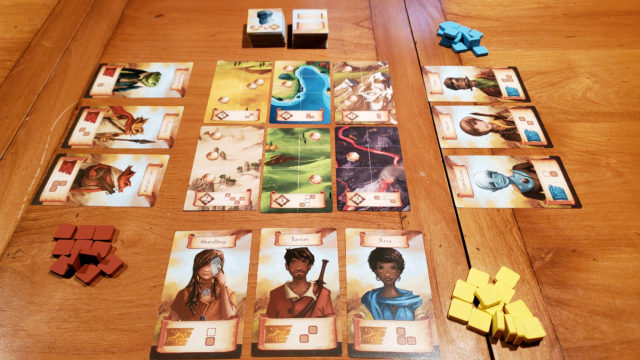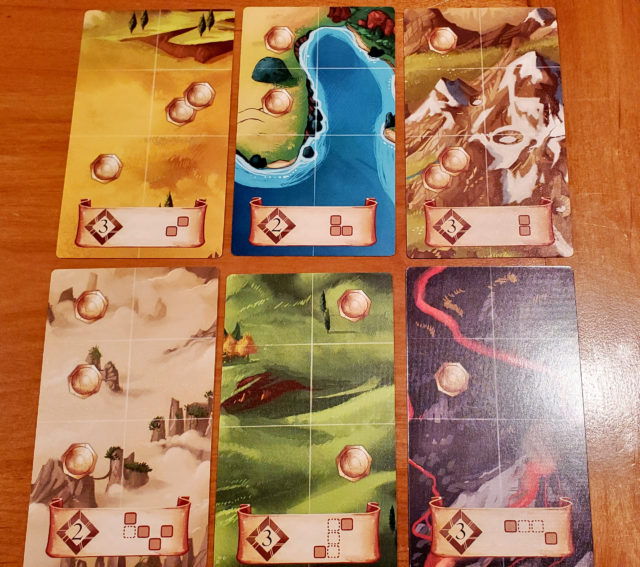Abstract games aren’t everyone’s jam. I’m not the best spatial/visual gamer and when it comes to games with little-to-no theme or an over emphasis on spatial arrangement, I get anxious. I either take too long to make a decision or choose something with hardly any consideration. Certain styles of games can trip up a lot of gamers. For me, it’s games like Galaxy Trucker, Yinsh, and Chess.
Fortunately, there is a sub-genre of abstract games that incorporates a combination of slight luck, player engagement, and light theme. These are the kind of abstract games that I can sink my teeth into. They have just enough variety, player interaction, luck and catch-up mechanisms that I feel less stress and performance anxiety when I play these kinds of games. In the past couple of years, Azul and its spin offs (Stained Glass of Sintra and Summer Pavilion) have successfully shown gamers that the abstract strategy category has a real market and gamers like me appreciate this kind of game.

Roam is one of these abstract strategy games and I’m glad that I picked up a copy a couple months ago. The game places itself in the same setting as Above and Below, Near and Far, Islebound, and City of Iron, all designed by Ryan Laukat, but this game doesn’t necessarily fit the same category of the games mentioned: strategy with storytelling elements. Roam is simpler and shorter than all of Laukat’s other games. I appreciate the effort to incorporate Roam into an existing story-world, but it isn’t integral to understanding the game mechanics and how to win Roam. The story goes like this: players search for lost, wandering characters in an attempt to awaken them from a sleep. Players do this by placing square discs on centralized land cards in unique patterns in order to gain area majority. [see image 161657]
Set-up is easy and takes hardly any time. The character/land cards are shuffled, and 6 cards are dealt to the center to create a 2×3 map. The remaining character/land cards are set aside. Each player starts the game with the same 3 cards that they place in front of them, facing the center of the table. With the maximum of 4 players, that means that each player will be facing one of the four sides of the map. [see image 161744] I like this because it evens the playing field, so to speak. In some games, there are varying start abilities or random card draws which can heavily influence players from the start. In Roam, each player begins with the same character cards because they are applied to the central map based on the direction the player faces, thus making the set-up unique but fair. This is a challenging task to accomplish, but Roam does it well.

On their turn, players activate one of their characters: they place discs according to the matching configuration at the bottom of the card onto the central map. This kind of player action reminds me of Tash-Kalar’s basic mechanism: choosing a card with specific configuration and placing markers on the centralized board to take control of an area. [see image 162036] In Roam, if a player’s disc covers up a coin symbol, they receive a coin from the bank. If all 6 spots on a land card have a disc by the end of a player’s turn, the card is resolved. The player with the majority area control wins the card and adds it to their player area, active side up. If players tie for the majority, they each bid gold to receive the card. All other contributing players receive a coin for presence on the land card. Once a player has 10 characters (including their original 3), the end of the game is triggered.
The game itself is very satisfying. Each turn goes quickly and the game ends at a good place in the players’ acquisition of victory points. In addition, there are additional artifact cards that any seasoned gamer can add on the first game that adds more choice to each player’s turn. Overall, a game for 3 players new to Roam takes 40 minutes. After that, a game might take 30 minutes once everyone knows how to play.
The coolest part about this game is how economic and easy to read the cards are: the character cards are double-sided with the land cards on the other side. At the bottom of these land cards is a smaller picture of the kind of character ability that appears on the other side, which prevents players from needlessly flipping cards over. The iconography is clear and easy to understand, which makes turns relatively quick. Lastly, the cards and graphics in the Roam are aesthetically appealing, too. [see image 161804]

Roam is straightforward and clean, but don’t be deceived! It’s not an empty abstract game. It is complex enough to engage any gamer that wants to maximize their turn, make the best strategic plays, and be challenged with a shared central area that all players are fighting over. And while the game works through area control, it’s not so aggressive that players who avoid conflict will still have a good time playing this game. If someone blocks your next play, there are plenty of other opportunities elsewhere on the map. Also, artifacts and coins should factor into a player’s strategy: using these abilities on your turn can make the difference between winning and losing.
Roam is the perfect game for a group of 2-4 who are just starting their gaming session. The time it takes to play a game is just the right amount: 30-45 minutes. It’s a beautiful game that deserves to hit everyone’s table at least once. Be warned, though, that once you try it, you’ll want to play again, attempting to flex those card management and artifact abilities.
On a final note I attended Board Game Geek Convention in Dallas, Texas, last November and had the pleasure of learning this quick, fun game that hits my “abstract game sweet spot.” Over the years, the convention has expanded the Exhibitor Hall and now it offers dozens of opportunities to try new, hot games released in the fall and straight from Essen. To my delight, the designer, Ryan Laukat, taught Roam to my husband, our friend, and me. So if you ever get the chance to attend conventions, you should set aside time during the working hours of the Exhibitor Hall to demo games that you are interested in. You always get one-on-one attention from the booth worker, and they are usually an integral part to the game reaching the table. I send a hearty thank you to the professional and kind demonstration by Ryan Laukat. I can’t wait for his next design in this wonderful world of Arzium: Sleeping Gods (already backed on Kickstarter!).
Comments
No comments yet! Be the first!